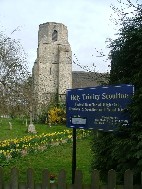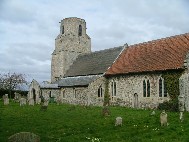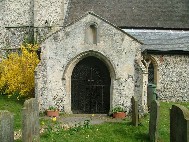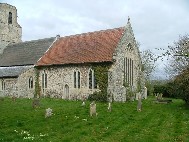| |
|
Holy
Trinity, Scoulton
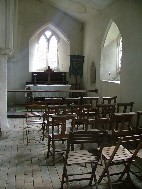 |
|
This
beautiful church is set not far from the main
Norwich to Watton road, but the churchyard is
hedged in and so beautiful that you might be
miles from anywhere. On this spring day it was
one of the loveliest places we visited. Holy
Trinity sprawls like a contented lion in the
middle of the graveyard, its unusual unfinished
tower just short of being crowned with a spire.
It may well be that changing economic fortunes in
the years after the Black Death carried off half
of Norfolk's population may have put paid to
that. The nave is thatched, the aisles
have slate roofs and the chancel has tiles. How
unusual to see three different materials on the
one building. There are aisles to north and
south, but no chancel, creating the impression of
a wide, low structure. The windows about are all
late 13th or early 14th century, all filled with
clear glass, and this gives the interior of the
church a very special atmosphere from the moment
you open the south door, which is old too.
|
On this
sunny day we stepped into a wide, square, light space,
motes of dust falling through the air. It was like
stepping back in time. The nave itself has a collection
of 19th century benches, but the font cover and pulpit on
the south side are older, probably 17th century. The
pulpit on the north side is a modern copy of the old one,
and it seemed most unusual to see the two together.
Jacobean panelling has been set behind the pulpits to
form kind of low screen, which turns eastward at the
entrance to the chancel. They create an effect something
between box pews and return stalls, although in fact
there is no attached seating on the eastern side. I
wonder if it might actually be in its original place
rather than a modern resetting from elsewhere.
If you
like puzzles, there is a good one in the north wall of
the chancel, behind the organ. Here, you will find the
recess of an Easter Sepulchre, but in its shelf are five
deep hollows, holes about 10cm across and 15cm deep.
Cautley thought they might be for cresset lights,
devotional candles made by floating a wick in oil; but as
Mortlock points out, the holes are much too large, they
would take almost a pint of oil each. Pevsner, wisely,
keeps his counsel and does not offer a solution.
| The
answer may lie in understanding quite how an
Easter Sepulchre was used. During the Holy
Thursday liturgy, the host would be removed from
the tabernacle and placed in a shrine set up
especially for the purpose in the Easter
Sepuchre. There it would remain until
triumphantly brought back to the altar during the
liturgy of the Easter Vigil. But what
was the Sepulchre used for at other times? It was
usually the tomb of an important local, who had
paid for it specifically for this purpose. His
effigy would be removed from the recess during
Holy Week, and replaced after Easter. Most often,
this would be a stone effigy, and its weight
alone would normally keep it in place. But a few
effigies found in East Anglian churches are made
from wood, and I would suggest that these five
holes contained the fixings for a wooden effigy.
|
|
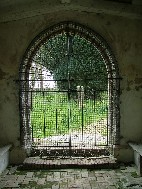 |
|
|
|


